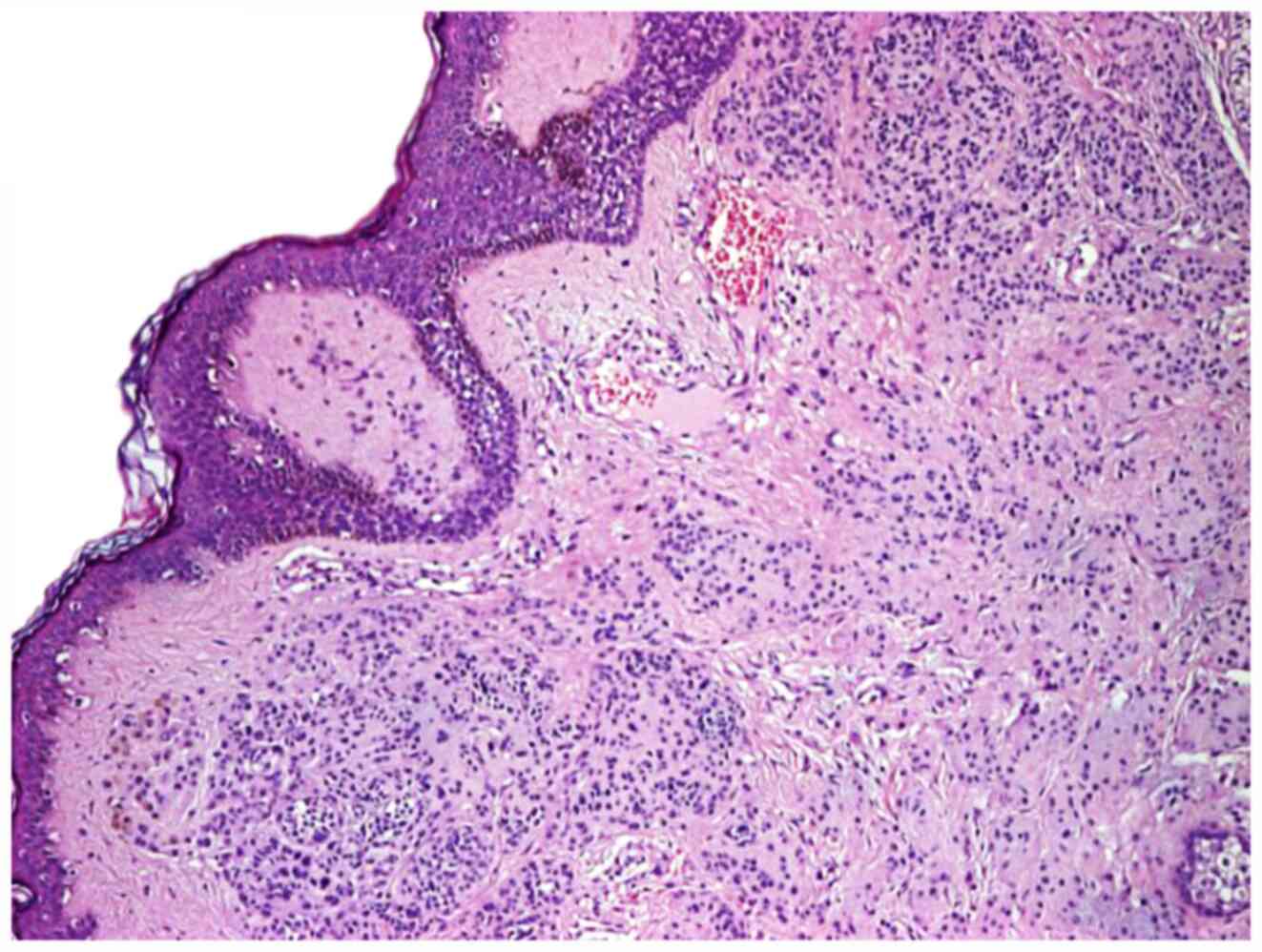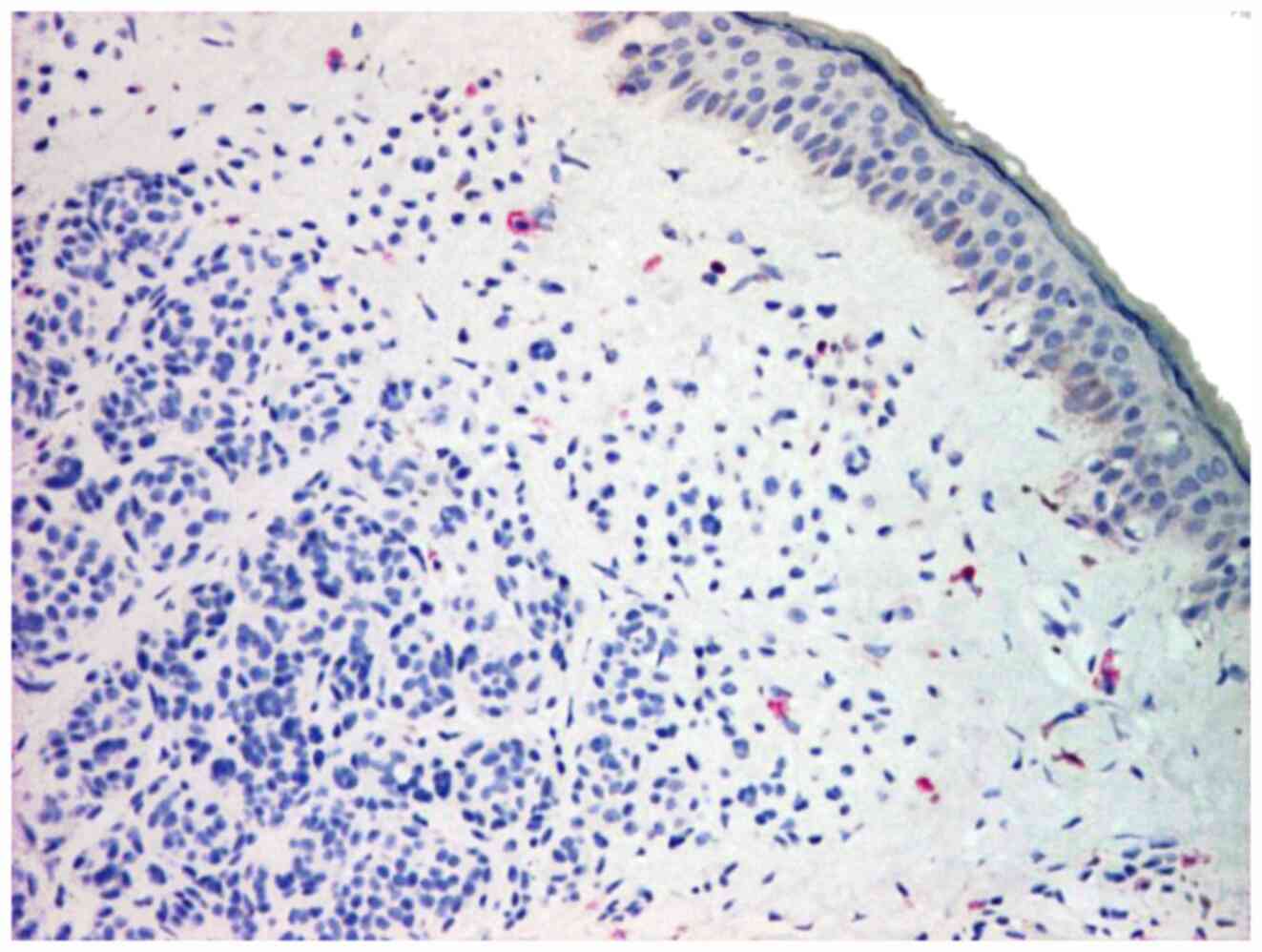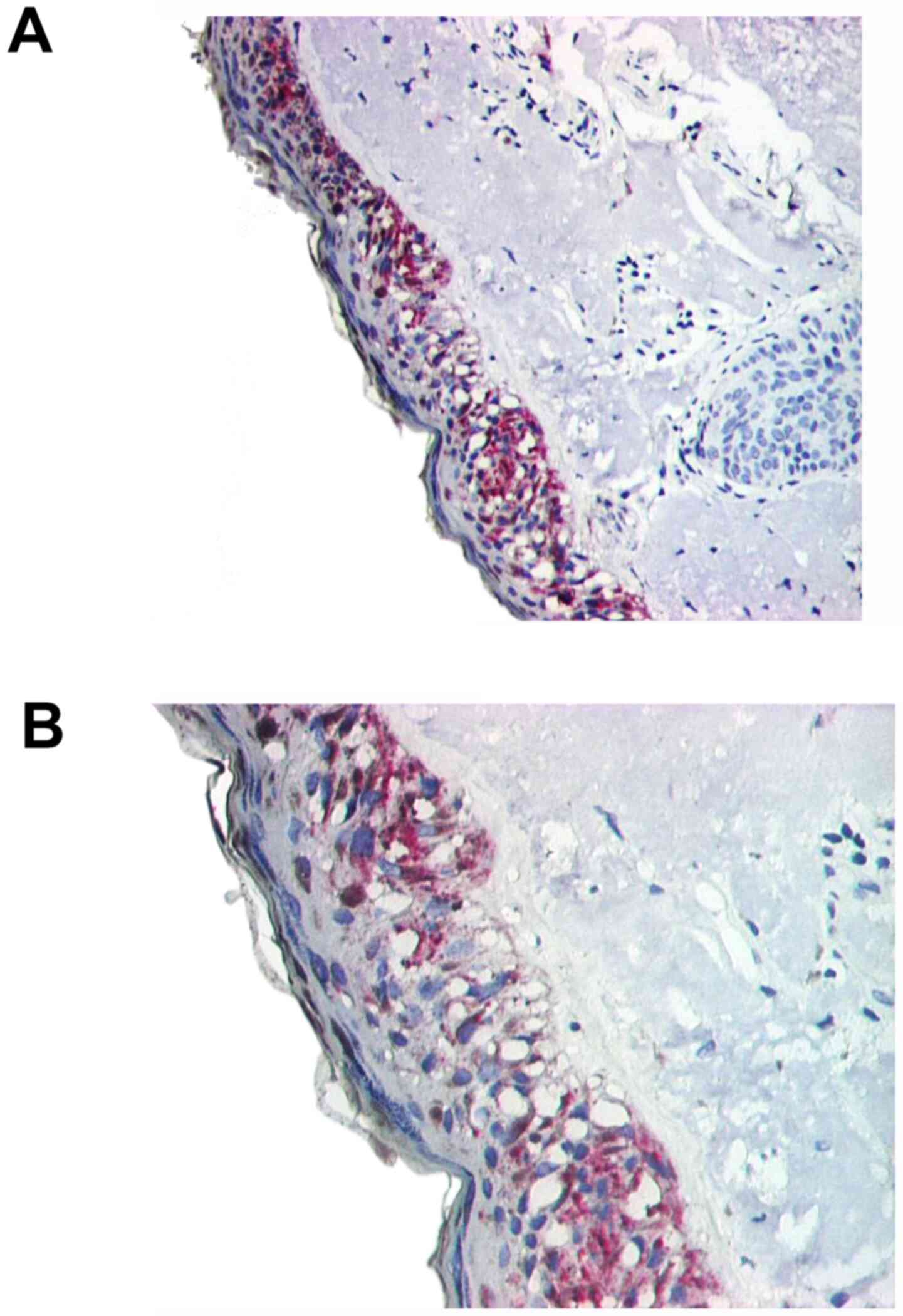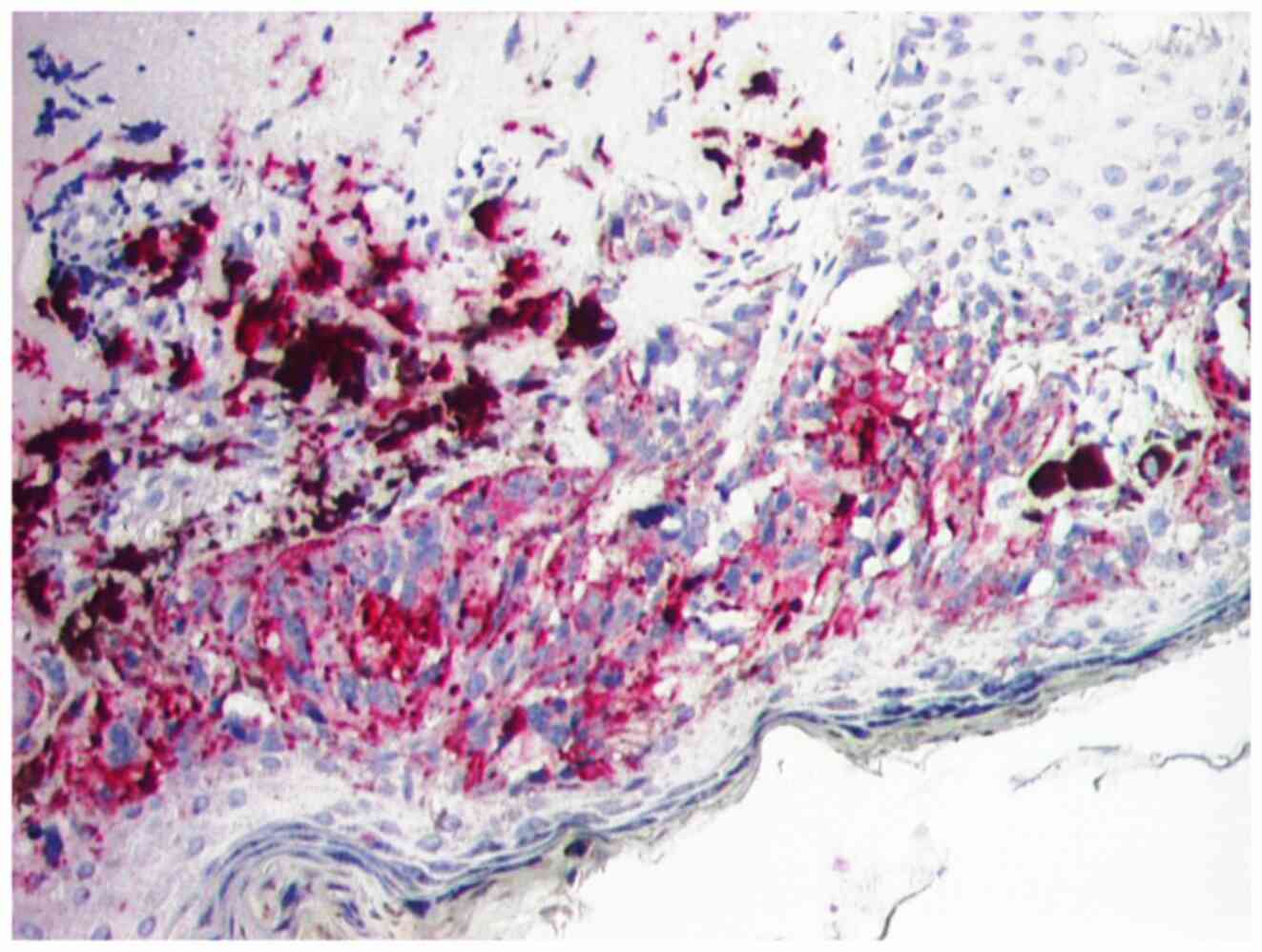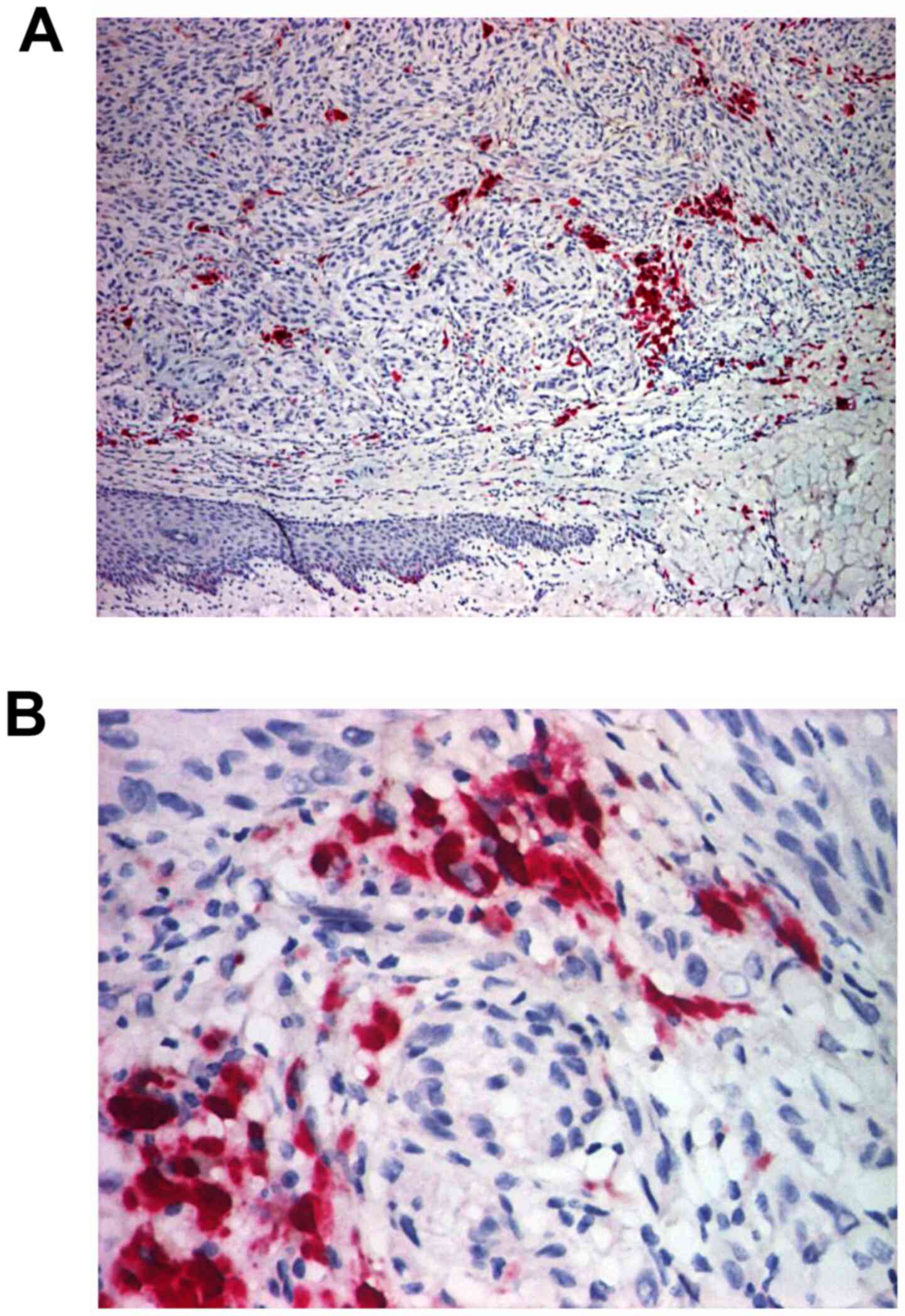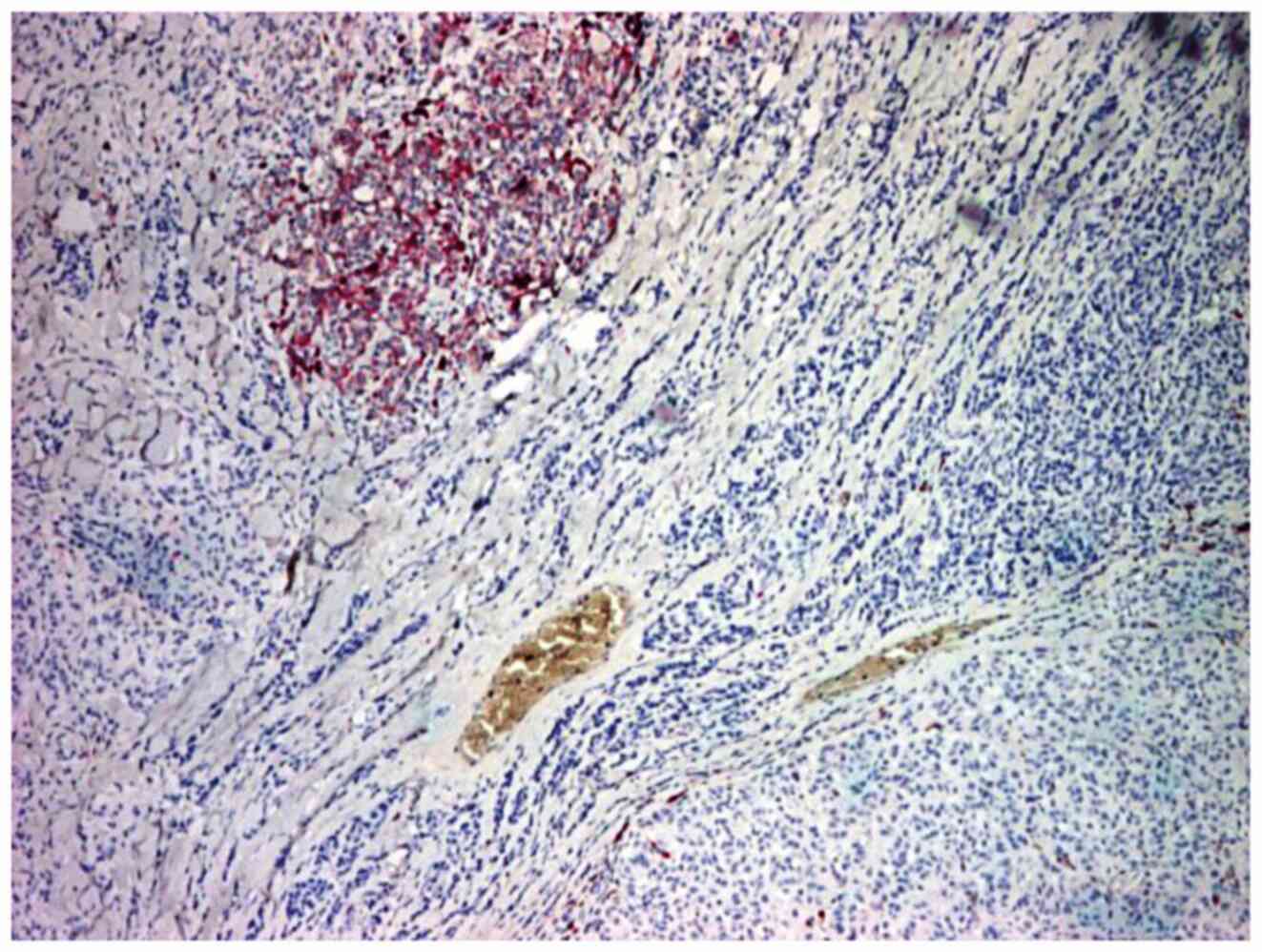|
1
|
Besmer P, Murphy JE, George PC, Qiu FH,
Bergold PJ, Lederman L, Snyder HW Jr, Brodeur D, Zuckerman EE and
Hardy WD: A new acute transforming feline retrovirus and
relationship of its oncogene v-kit with the protein kinase gene
family. Nature. 320:415–421. 1986.PubMed/NCBI View
Article : Google Scholar
|
|
2
|
Yarden Y, Kuang WJ, Yang-Feng T, Coussens
L, Munemitsu S, Dull TJ, Chen E, Schlessinger J, Francke U and
Ullrich A: Human proto-oncogene c-kit: A new cell surface receptor
tyrosine kinase for an unidentified ligand. EMBO J. 6:3341–3351.
1987.PubMed/NCBI
|
|
3
|
Ashman LK: The biology of stem cell factor
and its receptor C-kit. Int J Biochem Cell Biol. 31:1037–1051.
1999.PubMed/NCBI View Article : Google Scholar
|
|
4
|
Ronnstrand L: Signal transduction via the
stem cell factor/c-Kit. Cell Mol Life Sci. 61:2535–2548.
2004.PubMed/NCBI View Article : Google Scholar
|
|
5
|
Arber DA, Tamayo R and Weiss LM: Paraffin
section detection of the c-kit gene product (CD117) in human
tissues: Value in the diagnosis of mast cell disorders. Hum Pathol.
29:498–504. 1998.PubMed/NCBI View Article : Google Scholar
|
|
6
|
Maranduca MA, Branisteanu D, Serban DN,
Branisteanu DC, Stoleriu G, Manolache N and Serban IL: Synthesis
and physiological implications of melanic pigments. Oncol Lett.
17:4183–4187. 2019.PubMed/NCBI View Article : Google Scholar
|
|
7
|
Blendea A, Georgescu CV, Tolea I,
Brănişteanu DE and Costache A: An unusual cutaneous malignant
melanoma arised de novo: A case report. Rom J Morphol Embryol.
56:1217–1221. 2015.PubMed/NCBI
|
|
8
|
Schatton T, Murphy GF, Frank NY, Yamaura
K, Waaga-Gasser AM, Gasser M, Zhan Q, Jordan S, Duncan LM,
Weishaupt C, et al: Identification of cells initiating human
melanomas. Nature. 451:345–349. 2008.PubMed/NCBI View Article : Google Scholar
|
|
9
|
Reginster MA, Pierard-Franchimont C,
Piérard GE and Quatresooz P: Molecular dermatopathology in
malignant melanoma. Dermatol Res Pract. 2012(684032)2012.PubMed/NCBI View Article : Google Scholar
|
|
10
|
Klein WM, Wu BP, Zhao S, Wu H,
Klein-Szanto AJ and Tahan SR: Increased expression of stem cell
markers in malignant melanoma. Mod Pathol. 20:102–107.
2007.PubMed/NCBI View Article : Google Scholar
|
|
11
|
Schatton T and Frank MH: Cancer stem cells
and human malignant melanoma. Pigment Cell Melanoma Res. 21:39–55.
2008.PubMed/NCBI View Article : Google Scholar
|
|
12
|
Rappa G, Fodstad O and Lorico A: The stem
cell-associated antigen CD133 (Prominin-1) is a molecular
therapeutic target for metastatic melanoma. Stem Cells.
26:3008–3017. 2008.PubMed/NCBI View Article : Google Scholar
|
|
13
|
Zurac S, Neagu M, Constantin C, Cioplea M,
Nedelcu R, Bastian A, Popp C, Nichita L, Andrei R, Tebeica T, et
al: Variations in the expression of TIMP1, TIMP2 and TIMP3 in
cutaneous melanoma with regression and their possible function as
prognostic predictors. Oncol Lett. 11:3354–3360. 2016.PubMed/NCBI View Article : Google Scholar
|
|
14
|
Quatresooz P, Pierard GE and
Pierard-Franchimont C: Mosan Study Group of Pigmented Tumors:
Molecular pathways supporting the proliferation staging of
malignant melanoma (Review). Int J Mol Med. 24:295–301.
2009.PubMed/NCBI View Article : Google Scholar
|
|
15
|
Quatresooz P and Piérard GE: Malignant
melanoma: From cell kinetics to micrometastases. Am J Clin
Dermatol. 12:77–86. 2011.PubMed/NCBI View Article : Google Scholar
|
|
16
|
Tsuura Y, Hiraki H, Watanabe K, Igarashi
S, Shimamura K, Fukuda T, Suzuki T and Seito T: Preferential
localization of c-kit product in tissue mast cells, basal cells of
skin, epithelial cells of breast, small cell lung carcinoma and
seminoma/dysgerminoma in human: Immunohistochemical study on
formalin-fixed, paraffin-embedded tissues. Virchows Arch.
424:135–141. 1994.PubMed/NCBI View Article : Google Scholar
|
|
17
|
Matsuda R, Takahashi T, Nakamura S, Sekido
Y, Nishida K, Seto M, Seito T, Sugiura T, Ariyoshi Y, Takahashi T,
et al: Expression of the c-kit protein in human solid tumors and in
corresponding fetal and adult normal tissues. Am J Pathol.
142:339–346. 1993.PubMed/NCBI
|
|
18
|
Hornick JL and Fletcher CD:
Immunohistochemical staining for KIT (CD117) in soft tissue
sarcomas is very limited in distribution. Am J Clin Pathol.
117:188–193. 2002.PubMed/NCBI View Article : Google Scholar
|
|
19
|
Went PT, Dirnhofer S, Bundi M, Mirlacher
M, Schraml P, Mangialaio S, Dimitrijevic S, Kononen J, Lugli A,
Simon R and Sauter G: Prevalence of KIT expression in human tumors.
J Clin Oncol. 22:4514–4522. 2004.PubMed/NCBI View Article : Google Scholar
|
|
20
|
Becker G, Schmitt-Graeff A, Ertelt V, Blum
HE and Allgaier HP: CD117 (c-kit) expression in human
hepatocellular carcinoma. Clin Oncol (R Coll Radiol). 19:204–208.
2007.PubMed/NCBI View Article : Google Scholar
|
|
21
|
Gibson PC and Cooper K: CD117 (KIT): A
diverse protein with selective applications in surgical pathology.
Adv Anat Pathol. 9:65–69. 2002.PubMed/NCBI View Article : Google Scholar
|
|
22
|
Fekete GL, Cotoi OS and Fekete JE:
Multiple nodular cutaneous metastases as the first clinical sign of
signet ring cell gastric carcinoma: Case report. Acta
Dermatovenerol Croat. 20:34–37. 2012.PubMed/NCBI
|
|
23
|
Torres-Cabala CA, Wang WL, Trent J, Yang
D, Chen S, Galbincea J, Kim KB, Woodman S, Davies M, Plaza JA, et
al: Correlation between KIT expression and KIT mutation in
melanoma: A study of 173 cases with emphasis on the
acral-lentiginous/mucosal type. Mod Pathol. 22:1446–1456.
2009.PubMed/NCBI View Article : Google Scholar
|
|
24
|
Isabel Zhu Y and Fitzpatrick JE:
Expression of c-kit (CD117) in Spitz nevus and malignant melanoma.
J Cutan Pathol. 33:33–37. 2006.PubMed/NCBI View Article : Google Scholar
|
|
25
|
Heinrich MC, Griffith DJ, Druker BJ, Wait
CL, Ott KA and Zigler AJ: Inhibition of c-kit receptor tyrosine
kinase activity by STI 571, a selective tyrosine kinase inhibitor.
Blood. 96:925–932. 2000.PubMed/NCBI
|
|
26
|
Hochhaus A, Druker B, Sawyers C, Guilhot
F, Schiffer CA, Cortes J, Niederwieser DW, Gambacorti-Passerini C,
Stone RM, Goldman J, et al: Favorable long-term follow-up results
over 6 years for response, survival, and safety with imatinib
mesylate therapy in chronic-phase chronic myeloid leukemia after
failure of interferon-alpha treatment. Blood. 111:1039–1043.
2008.PubMed/NCBI View Article : Google Scholar
|
|
27
|
Demetri GD, von Mehren M, Blanke CD, Van
den Abbeele AD, Eisenberg B, Roberts PJ, Heinrich MC, Tuveson DA,
Singer S, Janicek M, et al: Efficacy and safety of imatinib
mesylate in advanced gastrointestinal stromal tumors. N Engl J Med.
347:472–480. 2002.PubMed/NCBI View Article : Google Scholar
|
|
28
|
Heinrich MC, Corless CL, Demetri GD,
Blanke CD, von Mehren M, Joensuu H, McGreevey LS, Chen CJ, Van den
Abbeele AD, Druker BJ, et al: Kinase mutations and imatinib
response in patients with metastatic gastrointestinal stromal
tumors. J Clin Oncol. 21:4342–4349. 2003.PubMed/NCBI View Article : Google Scholar
|
|
29
|
Alexis JB, Martinez AE and Lutzky J: An
immunohistochemical evaluation of c-kit (CD-117) expression in
malignant melanoma, and results of imatinib mesylate (Gleevec)
therapy in three patients. Melanoma Res. 15:283–285.
2005.PubMed/NCBI View Article : Google Scholar
|
|
30
|
Wyman K, Atkins MB, Prieto V, Eton O,
McDermott DF, Hubbard F, Byrnes C, Sanders K and Sosman JA:
Multicenter Phase II trial of high-dose imatinib mesylate in
metastatic melanoma: Significant toxicity with no clinical
efficacy. Cancer. 106:2005–2011. 2006.PubMed/NCBI View Article : Google Scholar
|
|
31
|
Ugurel S, Hildenbrand R, Zimpfer A, La
Rosée P, Paschka P, Sucker A, Keikavoussi P, Becker JC, Rittgen W,
Hochhaus A and Schadendorf D: Lack of clinical efficacy of imatinib
in metastatic melanoma. Br J Cancer. 92:1398–1405. 2005.PubMed/NCBI View Article : Google Scholar
|
|
32
|
Antonescu CR, Busam KJ, Francone TD, Wong
GC, Guo T, Agaram NP, Besmer P, Jungbluth A, Gimbel M, Chen CT, et
al: L576P KIT mutation in anal melanomas correlates with KIT
protein expression and is sensitive to specific kinase inhibition.
Int J Cancer. 121:257–264. 2007.PubMed/NCBI View Article : Google Scholar
|
|
33
|
Jiang X, Zhou J, Yuen NK, Corless CL,
Heinrich MC, Fletcher JA, Demetri GD, Widlund HR, Fisher DE and
Hodi FS: Imatinib targeting of KIT-mutant oncoprotein in melanoma.
Clin Cancer Res. 14:7726–7732. 2008.PubMed/NCBI View Article : Google Scholar
|
|
34
|
Curtin JA, Busam K, Pinkel D and Bastian
BC: Somatic activation of KIT in distinct subtypes of melanoma. J
Clin Oncol. 24:4340–4346. 2006.PubMed/NCBI View Article : Google Scholar
|
|
35
|
Guo J, Si L, Kong Y, Flaherty KT, Xu X,
Zhu Y, Corless CL, Li L, Li H, Sheng X, et al: Phase II,
open-label, single-arm trial of imatinib mesylate in patients with
metastatic melanoma harboring c-kit mutation or amplification. J
Clin Oncol. 29:2904–2909. 2011.PubMed/NCBI View Article : Google Scholar
|
|
36
|
Carvajal RD, Antonescu CR, Wolchok JD,
Chapman PB, Roman RA, Teitcher J, Panageas KS, Busam KJ,
Chmielowski B, Lutzky J, et al: KIT as a therapeutic target in
metastatic melanoma. JAMA. 305:2327–2334. 2011.PubMed/NCBI View Article : Google Scholar
|
|
37
|
Guerriere-Kovach PM, Hunt EL, Patterson
JW, Glembocki DJ, English JC III and Wick MR: Primary melanoma of
the skin and cutaneous melanomatous metastases: Comparative
histologic features and immunophenotypes. Am J Clin Pathol.
122:70–77. 2004.PubMed/NCBI View Article : Google Scholar
|
|
38
|
Grange JD, Duquesne N, Roubeyrol F,
Branisteanu D, Sandon K, Fleury J, Gerard JP, Chauvel P, Pinzaru G,
Jean-Louis B and Bievelez B: Double irradiation for macroscopic
radioresistance or recurrence of melanomas of the posterior uvea:
Clinical, ballistic, therapeutic and prognostic aspects. Series of
19 cases among 462 patients. J Fr Ophtalmol. 22:1054–1063.
1999.PubMed/NCBI
|
|
39
|
Kim KB, Eton O, Davis DW, Frazier ML,
McConkey DJ, Diwan AH, Papadopoulos NE, Bedikian AY, Camacho LH,
Ross MI, et al: Phase II trial of imatinib mesylate in patients
with metastatic melanoma. Br J Cancer. 99:734–740. 2008.PubMed/NCBI View Article : Google Scholar
|
|
40
|
Ancuceanu R, Dinu M, Neaga I, Laszlo FG
and Boda D: Development of QSAR machine learning-based models to
forecast the effect of substances on malignant melanoma cells.
Oncol Lett. 17:4188–4196. 2019.PubMed/NCBI View Article : Google Scholar
|
|
41
|
Willmore-Payne C, Layfield LJ and Holden
JA: c-Kit mutation analysis for diagnosis of gastrointestinal
stromal tumors in fine needle aspiration specimens. Cancer.
105:165–170. 2005.PubMed/NCBI View Article : Google Scholar
|
|
42
|
Willmore-Payne C, Holden JA, Tripp S and
Layfield LJ: Human malignant melanoma: Detection of BRAF- and
c-kit-activating mutations by high-resolution amplicon melting
analysis. Hum Pathol. 36:486–493. 2005.PubMed/NCBI View Article : Google Scholar
|
|
43
|
Fiorentini G, Rossi S, Lanzanova G,
Bernardeschi P, Dentico P and De Giorgi U: Potential use of
imatinib mesylate in ocular melanoma and liposarcoma expressing
immunohistochemical c-Kit (CD117). Ann Oncol.
14(805)2003.PubMed/NCBI View Article : Google Scholar
|
|
44
|
Lutzky J, Bauer J and Bastian BC:
Dose-dependent, complete response to imatinib of a metastatic
mucosal melanoma with a K642E KIT mutation. Pigment Cell Melanoma
Res. 21:492–493. 2008.PubMed/NCBI View Article : Google Scholar
|
|
45
|
Medinger M, Kleinschmidt M, Mross K,
Wehmeyer B, Unger C, Schaefer HE, Weber R and Azemar M: c-Kit
(CD117) expression in human tumors and its prognostic value: An
immunohistochemical analysis. Pathol Oncol Res. 16:295–301.
2010.PubMed/NCBI View Article : Google Scholar
|
|
46
|
Alessandrini L, Parrozzani R, Bertorelle
R, Valentini E, Candiotto C, Giacomelli L, Midena E and Blandamura
S: C-Kit SCF receptor (CD117) expression and KIT gene mutation in
conjunctival pigmented lesions. Acta Ophthalmol. 91:e641–e645.
2013.PubMed/NCBI View Article : Google Scholar
|
|
47
|
Grichnik JM, Burch JA, Burchette J and
Shea CR: The SCF/KIT pathway plays a critical role in the control
of normal human melanocyte homeostasis. J Invest Dermatol.
111:233–238. 1998.PubMed/NCBI View Article : Google Scholar
|
|
48
|
Grichnik JM: Kit and melanocyte migration.
J Invest Dermatol. 126:945–947. 2006.PubMed/NCBI View Article : Google Scholar
|
|
49
|
Holden JA, Willmore-Payne C and Layfield
LJ: Tyrosine kinase activating mutations in human malignancies:
Implications for diagnostic pathology. Exp Mol Pathol. 85:68–75.
2008.PubMed/NCBI View Article : Google Scholar
|
|
50
|
Alexeev V and Yoon K: Distinctive role of
the cKit receptor tyrosine kinase signaling in mammalian
melanocytes. J Invest Dermatol. 126:1102–1110. 2006.PubMed/NCBI View Article : Google Scholar
|
|
51
|
Ciobotaru OR, Lupu MN, Rebegea L,
Ciobotaru OC, Duca OM, Tatu AL, Voinescu CD, Stoleriu G, Earar K
and Miulescu M: Dexamethasone-chemical structure and mechanisms of
action in prophylaxis of postoperative side effects. Rev Chim
(Bucharest). 70:843–847. 2019.
|
|
52
|
Caruntu C, Boda D, Constantin C, Caruntu A
and Neagu M: Catecholamines increase in vitro proliferation of
murine B16F10 melanoma cells. Acta Endocrinol. 10:545–558.
2014.
|
|
53
|
Buga AM, Docea AO, Albu C, Malin RD,
Branisteanu DE, Ianosi G, Ianosi SL, Iordache A and Calina D:
Molecular and cellular stratagem of brain metastases associated
with melanoma. Oncol Lett. 17:4170–4175. 2019.PubMed/NCBI View Article : Google Scholar
|
|
54
|
Avram S, Coricovac DE, Pavel IZ, Pinzaru
J, Ghiulai R, Baderca F, Soica C, Muntean D, Branisteanu DE,
Spandidos DA, et al: Standardization of A375 human melanoma models
on chicken embryo chorioallantoic membrane and Balb/c nude mice.
Oncol Rep. 38:89–99. 2017.PubMed/NCBI View Article : Google Scholar
|
|
55
|
Kaplan FM, Mastrangelo MJ and Aplin AE:
The wrath of RAFs: Rogue behavior of B-RAF kinase inhibitors. J
Invest Dermatol. 130:2669–2671. 2010.PubMed/NCBI View Article : Google Scholar
|
|
56
|
Wagle N, Emery C, Berger MF, Davis MJ,
Sawyer A, Pochanard P, Kehoe SM, Johannessen CM, Macconaill LE,
Hahn WC, et al: Dissecting therapeutic resistance to RAF inhibition
in melanoma by tumor genomic profiling. J Clin Oncol. 29:3085–3096.
2011.PubMed/NCBI View Article : Google Scholar
|















